A Review on Experimental Measurements for Understanding Efficiency Droop in InGaN-Based Light-Emitting Diodes
Abstract
:1. Introduction
2. ABC Model
3. Electroluminescence (EL)
3.1. Temperature Dependent Electroluminescence (TDEL)
3.2. I-V Curve Measurement
3.3. Carrier Injection Efficiency (CIE) Measurement
4. Photoluminescence (PL)
5. Auger Electrons Measurement
6. Leakage Electron Measurement
7. Carrier Lifetime Measurement
8. Solutions to Overcome Efficiency Droop
9. Conclusions
- (1)
- Is the efficiency droop in InGaN-based LEDs more special compared with that in AlGaInP-based red LEDs? Now, carrier lifetime can be used to explain why blue LEDs exhibit more serious droop than red ones. Thus, it is not necessary to be tangled in an abnormal phenomenon to understand why a wide gap semiconductor has a larger Auger coefficient than a narrow gap semiconductor. In this sense, the efficiency droop in InGaN and AlGaInP may possess the same origins.
- (2)
- If Auger recombination is really a dominant factor for LED droop, what is the carrier dynamics model? Obviously, the conventional Cn3 term goes against the experimental results of carrier lifetime.
- (3)
- If injection loss is really a dominant factor for LED droop, what is the mechanics of carrier leakage? Why do almost all of the optimizing on EBL in LED structure still seem to not solve the problem thoroughly? Is it the Auger-assisted leakage?
- (4)
- How can the IQE, RRE and CIE of a LED be evaluated systematically and accurately without any assumption?
- (1)
- It should choose a state-of-the-art LED sample to do measurement.
- (2)
- It should measure an operating LED. PL measurement is not recommended because the droop is EL droop.
- (3)
- It should show absolute efficiency when comparing the droop behaviors. The relative value makes little sense.
- (4)
- It should not assume a 100% current injection efficiency when using ABC model.
- (5)
- Apparently, LED droop is current-dependent droop, but physically it is carrier concentration-dependent droop.
Acknowledgments
Author Contributions
Conflicts of Interest
References
- Steigerwald, D.A.; Bhat, J.C.; Collins, D.; Fletcher, R.M.; Holcomb, M.O.; Ludowise, M.J.; Martin, P.S.; Rudaz, S.L. Illumination with solid state lighting technology. IEEE J. Select. Top. Quantum Electron. 2002, 8, 310–320. [Google Scholar] [CrossRef]
- Crawford, M.H. LEDs for solid-state lighting: Performance challenges and recent advances. IEEE J. Select. Top. Quantum Electron. 2009, 15, 1028–1040. [Google Scholar] [CrossRef]
- Pimputkar, S.; Speck, J.S.; DenBaars, S.P.; Nakamura, S. Prospects for LED lighting. Nat. Photonics 2009, 3, 180–182. [Google Scholar] [CrossRef]
- The Nobel Prize in Physics 2014. Available online: http://www.nobelprize.org/nobel_prizes/physics/laureates/2014/ (accessed on 30 September 2017).
- Piprek, J. Efficiency droop in nitride-based light-emitting diodes. Phys. Status Solidi A 2010, 207, 2217–2225. [Google Scholar] [CrossRef]
- Cho, J.; Schubert, E.F.; Kim, J.K. Efficiency droop in light-emitting diodes: Challenges and countermeasures. Laser Photonics Rev. 2013, 7, 408–421. [Google Scholar] [CrossRef]
- Verzellesi, G.; Saguatti, D.; Meneghini, M.; Bertazzi, F.; Goano, M.; Meneghesso, G.; Zanoni, E. Efficiency droop in InGaN/GaN blue light-emitting diodes: Physical mechanisms and remedies. J. Appl. Phys. 2013, 114, 071101. [Google Scholar] [CrossRef]
- Komine, T.; Nakagawa, M. Fundamental analysis for visible-light communication system using LED lights. IEEE Trans. Consum. Electron. 2004, 50, 100–107. [Google Scholar] [CrossRef]
- Liao, C.-L.; Ho, C.-L.; Chang, Y.-F.; Wu, C.-H.; Wu, M.-C. High-speed light-emitting diodes emitting at 500 nm with 463-MHz modulation bandwidth. IEEE Electron. Dev. Lett. 2014, 35, 563–565. [Google Scholar] [CrossRef]
- Rozhansky, I.V.; Zakheim, D.A. Analysis of dependence of electroluminescence efficiency of AlInGaN LED heterostructures on pumping. Phys. Status Solidi (C) 2006, 3, 2160–2164. [Google Scholar] [CrossRef]
- Kim, M.H.; Schubert, M.F.; Dai, Q.; Kim, J.K.; Schubert, E.F.; Piprek, J.; Park, Y. Origin of efficiency droop in GaN-based light-emitting diodes. Appl. Phys. Lett. 2007, 91, 183507. [Google Scholar] [CrossRef]
- Shen, Y.C.; Mueller, G.O.; Watanabe, S.; Gardner, N.F.; Munkholm, A.; Krames, M.R. Auger recombination in InGaN measured by photoluminescence. Appl. Phys. Lett. 2007, 91, 141101. [Google Scholar] [CrossRef]
- Li, Y.L.; Huang, Y.R.; Lai, Y.H. Efficiency droop behaviors of InGaN/GaN multiple-quantum-well light-emitting diodes with varying quantum well thickness. Appl. Phys. Lett. 2007, 91, 181113. [Google Scholar] [CrossRef]
- Schubert, M.F.; Chhajed, S.; Kim, J.K.; Schubert, E.F.; Koleske, D.D.; Crawford, M.H.; Lee, S.R.; Fischer, A.J.; Thaler, G.; Banas, M.A. Effect of dislocation density on efficiency droop in GaInN/GaN light-emitting diodes. Appl. Phys. Lett. 2007, 91, 231114. [Google Scholar] [CrossRef]
- Gardner, N.F.; Müller, G.O.; Shen, Y.C.; Chen, G.; Watanabe, S.; Götz, W.; Krames, M.R. Blue-emitting InGaN–GaN double-heterostructure light-emitting diodes reaching maximum quantum efficiency above 200 A/cm2. Appl. Phys. Lett. 2007, 91, 243506. [Google Scholar] [CrossRef]
- Wang, L.; Wang, J.; Li, H.; Xi, G.; Jiang, Y.; Zhao, W.; Han, Y.; Luo, Y. Study on injection efficiency in InGaN/GaN multiple quantum wells blue light emitting diodes. Appl. Phys. Express 2008, 1, 021101. [Google Scholar] [CrossRef]
- Hader, J.; Moloney, J.V.; Pasenow, B.S.; Koch, W.; Sabathil, M.; Linder, N.; Lutgen, S. On the importance of radiative and Auger losses in GaN-based quantum wells. Appl. Phys. Lett. 2008, 92, 261103. [Google Scholar] [CrossRef]
- Schubert, M.F.; Xu, J.; Kim, J.K.; Schubert, E.F.; Kim, M.H.; Yoon, S.; Lee, S.M.; Sone, C.; Sakong, T.; Park, Y. Polarization-matched GaInN/AlGaInN multi-quantum-well light-emitting diodes with reduced efficiency droop. Appl. Phys. Lett. 2008, 93, 041102. [Google Scholar] [CrossRef]
- Xie, J.; Ni, X.; Fan, Q.; Shimada, R.; Özgür, Ü.; Morkoç, H. On the efficiency droop in InGaN multiple quantum well blue light emitting diodes and its reduction with p-doped quantum well barriers. Appl. Phys. Lett. 2008, 93, 121107. [Google Scholar] [CrossRef]
- Ni, X.; Fan, Q.; Shimada, R.; Özgür, Ü.; Morkoç, H. Reduction of efficiency droop in InGaN light emitting diodes by coupled quantum wells. Appl. Phys. Lett. 2008, 93, 171113. [Google Scholar] [CrossRef]
- Shen, K.C.; Chen, C.Y.; Chen, H.L.; Huang, C.F.; Kiang, Y.W.; Yang, C.C.; Yang, Y.J. Enhanced and partially polarized output of a light-emitting diode with its InGaN/GaN quantum well coupled with surface plasmons on a metal grating. Appl. Phys. Lett. 2008, 93, 231111. [Google Scholar] [CrossRef]
- Xu, J.; Schubert, M.F.; Noemaun, A.N.; Zhu, D.; Kim, J.K.; Schubert, E.F.; Kim, M.H.; Chung, H.J.; Yoon, S.; Sone, C.; et al. Reduction in efficiency droop, forward voltage, ideality factor, and wavelength shift in polarization-matched GaInN/GaInN multi-quantum-well light-emitting diodes. Appl. Phys. Lett. 2009, 94, 011113. [Google Scholar] [CrossRef]
- Vampola, K.J.; Iza, M.; Keller, S.; DenBaars, S.P.; Nakamura, S. Measurement of electron overflow in 450 nm InGaN light-emitting diode structures. Appl. Phys. Lett. 2009, 94, 061116. [Google Scholar] [CrossRef]
- Han, S.H.; Lee, D.Y.; Lee, S.J.; Cho, C.Y.; Kwon, M.K.; Lee, S.P.; Park, S.J. Effect of electron blocking layer on efficiency droop in InGaN/GaN multiple quantum well light-emitting diodes. Appl. Phys. Lett. 2009, 94, 231123. [Google Scholar] [CrossRef]
- Delaney, K.T.; Rinke, P.; Van de Walle, C.G. Auger recombination rates in nitrides from first principles. Appl. Phys. Lett. 2009, 94, 191109. [Google Scholar] [CrossRef]
- Kuo, Y.K.; Chang, J.Y.; Tsai, M.C.; Yen, S.H. Advantages of blue InGaN multiple-quantum well light-emitting diodes with InGaN barriers. Appl. Phys. Lett. 2009, 95, 011116. [Google Scholar] [CrossRef]
- Ryu, H.Y.; Kim, H.S.; Shim, J.I. Rate equation analysis of efficiency droop in InGaN light-emitting diodes. Appl. Phys. Lett. 2009, 95, 081114. [Google Scholar] [CrossRef]
- David, A.; Grundmann, M.J. Droop in InGaN light-emitting diodes: A differential carrier lifetime analysis. Appl. Phys. Lett. 2010, 96, 103504. [Google Scholar] [CrossRef]
- Hader, J.; Moloney, J.V.; Koch, S.W. Density-activated defect recombination as a possible explanation for the efficiency droop in GaN-based diodes. Appl. Phys. Lett. 2010, 96, 221106. [Google Scholar] [CrossRef]
- Lu, C.F.; Liao, C.H.; Chen, C.Y.; Hsieh, C.; Kiang, Y.W.; Yang, C.C. Reduction in the efficiency droop effect of a light-emitting diode through surface plasmon coupling. Appl. Phys. Lett. 2010, 96, 261104. [Google Scholar] [CrossRef]
- Dai, Q.; Shan, Q.; Wang, J.; Chhajed, S.; Cho, J.; Schubert, E.F.; Crawford, M.H.; Koleske, D.D.; Kim, M.H.; Park, Y. Carrier recombination mechanisms and efficiency droop in GaInN/GaN light-emitting diodes. Appl. Phys. Lett. 2010, 97, 133507. [Google Scholar] [CrossRef]
- Wang, J.; Wang, L.; Zhao, W.; Hao, Z.; Luo, Y. Understanding efficiency droop effect in InGaN/GaN multiple-quantum-well blue light-emitting diodes with different degree of carrier localization. Appl. Phys. Lett. 2010, 97, 201112. [Google Scholar] [CrossRef]
- Wang, C.H.; Ke, C.C.; Lee, C.Y.; Chang, S.P.; Chang, W.T.; Li, J.C.; Li, Z.Y.; Yang, H.C.; Kuo, H.C.; Lu, T.C.; et al. Hole injection and efficiency droop improvement in InGaN/GaN light-emitting diodes by band-engineered electron blocking layer. Appl. Phys. Lett. 2010, 97, 261103. [Google Scholar] [CrossRef]
- Dai, Q.; Shan, Q.; Cho, J.; Schubert, E.F.; Crawford, M.H.; Koleske, D.D.; Park, Y. On the symmetry of efficiency-versus-carrier-concentration curves in GaInN/GaN light-emitting diodes and relation to droop-causing mechanisms. Appl. Phys. Lett. 2011, 98, 033506. [Google Scholar] [CrossRef]
- Kioupakis, E.; Rinke, D.P.K.T.; Van de Walle, C.G. Indirect Auger recombination as a cause of efficiency droop in nitride light-emitting diodes. Appl. Phys. Lett. 2011, 98, 161107. [Google Scholar] [CrossRef]
- Wang, C.H.; Chang, S.P.; Ku, P.H.; Li, J.C.; Lan, Y.P.; Lin, C.C.; Yang, H.C.; Guo, H.C.; Lu, T.C.; Wang, S.C.; et al. Hole transport improvement in InGaN/GaN light-emitting diodes by graded-composition multiple quantum barriers. Appl. Phys. Lett. 2011, 99, 171106. [Google Scholar] [CrossRef]
- Hader, J.; Moloney, J.V.; Koch, S.W. Temperature-dependence of the internal efficiency droop in GaN-based diodes. Appl. Phys. Lett. 2011, 99, 181127. [Google Scholar] [CrossRef]
- Zhang, Y.Y.; Yin, Y.A. Performance enhancement of blue light-emitting diodes with a special designed AlGaN/GaN superlattice electron-blocking layer. Appl. Phys. Lett. 2011, 99, 221103. [Google Scholar] [CrossRef]
- Meyaard, D.S.; Lin, G.B.; Shan, Q.; Cho, J.; Schubert, E.F.; Shim, H.; Kim, M.H.; Sone, C. Asymmetry of carrier transport leading to efficiency droop in GaInN based light-emitting diodes. Appl. Phys. Lett. 2011, 99, 251115. [Google Scholar] [CrossRef]
- Hammersley, S.; Watson-Parris, D.; Dawson, P.; Godfrey, M.J.; Badcock, T.J.; Kappers, M.J.; McAleese, C.; Oliver, R.A.; Humphreys, C.J. The consequences of high injected carrier densities on carrier localization and efficiency droop in InGaN/GaN quantum well structures. J. Appl. Phys. 2012, 111, 083512. [Google Scholar] [CrossRef]
- Wang, J.; Wang, L.; Wang, L.; Hao, Z.; Luo, Y.; Dempewolf, A.; Müller, M.; Bertram, F.; Christen, J. An improved carrier rate model to evaluate internal quantum efficiency and analyze efficiency droop origin of InGaN based light-emitting diodes. J. Appl. Phys. 2012, 112, 023107. [Google Scholar] [CrossRef]
- Ahn, B.J.; Kim, T.S.; Dong, Y.; Hong, M.T.; Song, J.H.; Song, J.H.; Yuh, H.K.; Choi, S.C.; Bae, D.K.; Moon, Y. Experimental determination of current spill-over and its effect on the efficiency droop in InGaN/GaN blue-light-emitting-diodes. Appl. Phys. Lett. 2012, 100, 031905. [Google Scholar] [CrossRef]
- Meyaard, D.S.; Shan, Q.; Cho, J.; Schubert, E.F.; Han, S.H.; Kim, M.H.; Sone, C.; Oh, S.J.; Kim, J.K. Temperature dependent efficiency droop in GaInN light-emitting diodes with different current densities. Appl. Phys. Lett. 2012, 100, 081106. [Google Scholar] [CrossRef]
- Ryu, H.Y.; Shin, D.S.; Shim, J.I. Analysis of efficiency droop in nitride light-emitting diodes by the reduced effective volume of InGaN active material. Appl. Phys. Lett. 2012, 100, 131109. [Google Scholar] [CrossRef]
- Shin, D.S.; Han, D.P.; Oh, J.Y.; Shim, J.I. Study of droop phenomena in InGaN-based blue and green light-emitting diodes by temperature-dependent electroluminescence. Appl. Phys. Lett. 2012, 100, 153506. [Google Scholar] [CrossRef]
- Lin, G.B.; Meyaard, D.; Cho, J.; Schubert, E.F.; Shim, H.; Sone, C. Analytic model for the efficiency droop in semiconductors with asymmetric carrier-transport properties based on drift-induced reduction of injection efficiency. Appl. Phys. Lett. 2012, 100, 161106. [Google Scholar] [CrossRef]
- Deppner, M.; Römer, F.; Witzigmann, B. Auger carrier leakage in III-nitride quantum-well light emitting diodes. Phys. Status Solidi RRL 2012, 6, 418–420. [Google Scholar] [CrossRef]
- Davies, M.J.; Badcock, T.J.; Dawson, P.; Kappers, M.J.; Oliver, R.A. High excitation carrier density recombination dynamics of InGaN/GaN quantum well structures: Possible relevance to efficiency droop. Appl. Phys. Lett. 2013, 102, 022106. [Google Scholar] [CrossRef]
- Vaxenburg, R.; Lifshitz, E.; Efros, A.L. Suppression of Auger-stimulated efficiency droop in nitride-based light emitting diodes. Appl. Phys. Lett. 2013, 102, 031120. [Google Scholar] [CrossRef]
- Chen, H.S.; Chen, C.F.; Kuo, Y.; Chou, W.H.; Shen, C.H.; Jung, Y.L.; Yang, C.C. Surface plasmon coupled light-emitting diode with metal protrusions into p-GaN. Appl. Phys. Lett. 2013, 102, 041108. [Google Scholar] [CrossRef]
- Meyaard, D.S.; Lin, G.B.; Cho, J.; Schubert, E.F.; Shim, H.; Han, S.H.; Kim, M.H.; Sone, C.; Kim, Y.S. Identifying the cause of the efficiency droop in GaInN light-emitting diodes by correlating the onset of high injection with the onset of the efficiency droop. Appl. Phys. Lett. 2013, 102, 251114. [Google Scholar] [CrossRef]
- Binder, M.; Nirschl, A.; Zeisel, R.; Hager, T.; Lugauer, H.J.; Sabathil, M.; Bougeard, D.; Wagner, J.; Galler, B. Identification of nnp and npp Auger recombination as significant contributor to the efficiency droop in (GaIn)N quantum wells by visualization of hot carriers in photoluminescence. Appl. Phys. Lett. 2013, 103, 071108. [Google Scholar] [CrossRef]
- Bertazzi, F.; Zhou, X.; Goano, M.; Ghione, G.; Bellotti, E. Auger recombination in InGaN/GaN quantum wells: A full-Brillouin-zone study. Appl. Phys. Lett. 2013, 103, 081106. [Google Scholar] [CrossRef]
- Iveland, J.; Martinelli, L.; Peretti, J.; Speck, J.S.; Weisbuch, C. Direct measurement of Auger electrons emitted from a semiconductor light-emitting diode under electrical injection: Identification of the dominant mechanism for efficiency droop. Phys. Rev. Lett. 2013, 110, 177406. [Google Scholar] [CrossRef] [PubMed]
- Wierer, J.J.; Tsao, J.Y.; Sizov, D.S. Comparison between blue lasers and light-emitting diodes for future solid-state lighting. Laser Photonics Rev. 2013, 7, 963–993. [Google Scholar] [CrossRef]
- Han, D.P.; Zheng, D.G.; Oh, C.H.; Kim, H.; Shim, J.I.; Shin, D.S.; Kim, K.S. Nonradiative recombination mechanisms in InGaN/GaN-based light-emitting diodes investigated by temperature-dependent measurements. Appl. Phys. Lett. 2014, 104, 151108. [Google Scholar] [CrossRef]
- Iveland, J.; Piccardo, M.; Martinelli, L.; Peretti, J.; Choi, J.W.; Young, N.; Nakamura, S.; Speck, J.S.; Weisbuch, C. Origin of electrons emitted into vacuum from InGaN light emitting diodes. Appl. Phys. Lett. 2014, 105, 052103. [Google Scholar] [CrossRef]
- Han, D.P.; Kim, H.; Shim, J.I.; Shin, D.S.; Kim, K.S. Influence of carrier overflow on the forward-voltage characteristics of InGaN-based light-emitting diodes. Appl. Phys. Lett. 2014, 105, 191114. [Google Scholar] [CrossRef]
- Piprek, J.; Römer, F.; Witzigmann, B. On the uncertainty of the Auger recombination coefficient extracted from InGaN/GaN light-emitting diode efficiency droop measurements. Appl. Phys. Lett. 2015, 106, 101101. [Google Scholar] [CrossRef]
- Jung, E.; Hwang, G.; Chung, J.; Kwon, O.; Han, J.; Moon, Y.T.; Seong, T.Y. Investigating the origin of efficiency droop by profiling the temperature across the multi-quantum well of an operating light-emitting diode. Appl. Phys. Lett. 2015, 106, 041114. [Google Scholar] [CrossRef]
- Pozina, G.; Ciechonski, R.; Bi, Z.; Samuelson, L.; Monemar, B. Dislocation related droop in InGaN/GaN light emitting diodes investigated via cathodoluminescence. Appl. Phys. Lett. 2015, 107, 251106. [Google Scholar] [CrossRef]
- Meng, X.; Wang, L.; Hao, Z.; Luo, Y.; Sun, C.; Han, Y.; Xiong, B.; Wang, J.; Li, H. Study on efficiency droop in InGaN/GaN light-emitting diodes based on differential carrier lifetime analysis. Appl. Phys. Lett. 2016, 108, 013501. [Google Scholar] [CrossRef]
- Kim, T.; Seong, T.Y.; Kwon, O. Investigating the origin of efficiency droop by profiling the voltage across the multi-quantum well of an operating light-emitting diode. Appl. Phys. Lett. 2016, 108, 231101. [Google Scholar] [CrossRef]
- Bizarri, G.; Moses, W.W.; Singh, J.; Vasil’ev, A.N.; Williams, R.T. An analytical model of nonproportional scintillator light yield in terms of recombination rates. J. Appl. Phys. 2009, 105, 044507. [Google Scholar] [CrossRef]
- Singh, J. Study of nonproportionality in the light yield of inorganic scintillators. J. Appl. Phys. 2011, 110, 024503. [Google Scholar] [CrossRef]
- Xing, Y.; Wang, L.; Yang, D.; Wang, Z.; Hao, Z.; Luo, Y.; Sun, C.; Han, Y.; Xiong, B.; Wang, J.; et al. A novel model on time-resolved photoluminescence measurements of polar InGaN/GaN multi-quantum-well structures. Sci. Rep. 2017, 7, 45082. [Google Scholar] [CrossRef] [PubMed]
- Schulz, S.; Caro, M.A.; Coughlan, C.; O’Reilly, E.P. Atomistic analysis of the impact of alloy and well-width fluctuations on the electronic and optical properties of InGaN/GaN quantum wells. Phys. Rev. B 2015, 91, 35439. [Google Scholar] [CrossRef]
- Badcock, T.J.; Ali, M.; Zhu, T.; Pristovsek, M.; Oliver, R.A.; Shields, A.J. Radiative recombination mechanisms in polar and non-polar InGaN/GaN quantum well LED structures. Appl. Phys. Lett. 2016, 109, 151110. [Google Scholar] [CrossRef]
- Galler, B.; Drechsel, P.; Monnard, R.; Rode, P.; Stauss, P.; Froehlich, S.; Bergbauer, W.; Binder, M.; Sabathil, M.; Hahn, B.; et al. Influence of indium content and temperature on Auger-like recombination in InGaN quantum wells grown on (111) silicon substrates. Appl. Phys. Lett. 2012, 101, 131111. [Google Scholar] [CrossRef]
- Liu, Z.; Wei, T.; Guo, E.; Yi, X.; Wang, L.; Wang, J.; Wang, G.; Shi, Y.; Ferguson, I.; Li, J. Efficiency droop in InGaN/GaN multiple-quantum-well blue light-emitting diodes grown on free-standing GaN substrate. Appl. Phys. Lett. 2011, 99, 091104. [Google Scholar] [CrossRef]
- Li, X.; Liu, H.; Ni, X.; Özgür, Ü.; Morkoç, H. Effect of carrier spillover and Auger recombination on the efficiency droop in InGaN-based blue LEDs. Superlattices Microstruct. 2010, 47, 118–122. [Google Scholar] [CrossRef]
- Fujiwara, K.; Jimi, H.; Kaneda, K. Temperature-dependent droop of electroluminescence efficiency in blue (In,Ga)N quantum-well diodes. Phys. Status Solidi C 2009, 6, S814–S817. [Google Scholar] [CrossRef]
- Piprek, J. How to decide between competing efficiency droop models for GaN-based light-emitting diodes. Appl. Phys. Lett. 2015, 107, 031101. [Google Scholar] [CrossRef]
- Park, J.H.; Cho, J.; Schubert, E.F.; Kim, J.K. The effect of imbalanced carrier transport on the efficiency droop in GaInN-based blue and green light-emitting diodes. Energies 2017, 10, 1277. [Google Scholar] [CrossRef]
- Hurni, C.A.; David, A.; Cich, M.J.; Aldaz, R.I.; Ellis, B.; Huang, K.; Tyagi, A.; DeLille, R.A.; Craven, M.D.; Steranka, F.M.; et al. Bulk GaN flip-chip violet light-emitting diodes with optimized efficiency for high-power operation. Appl. Phys. Lett. 2015, 106, 031101. [Google Scholar] [CrossRef]
- Oh, N.-C.; Lee, J.-G.; Dong, Y.; Kim, T.-S.; Yu, H.-J.; Song, J.-H. Effect of p-AlGaN electron blocking layers on the injection and radiative efficiencies in InGaN/GaN light emitting diodes. Curr. Appl. Phys. 2015, 15, S7–S10. [Google Scholar] [CrossRef]
- Oh, N.-C.; Kim, T.-S.; Lim, S.-Y.; Moon, Y.; Hong, S.-K.; Song, J.-H. High temperature behavior of injection and radiative efficiencies and its effects on the efficiency droop in InGaN/GaN light emitting diodes. J. Nanosci. Nanotechnol. 2016, 16, 11640. [Google Scholar] [CrossRef]
- Kim, T.S.; Song, J.H. Personal Communication; Kongju National University: Kongju, Chungnam, Korea, 2017. [Google Scholar]
- Sadi, T.; Kivisaari, P.; Oksanen, J.; Tulkki, J. On the correlation of the Auger generated hot electron emission and efficiency droop in III-N light-emitting diodes. Appl. Phys. Lett. 2014, 105, 091106. [Google Scholar] [CrossRef]
- Zheng, J.; Wang, L.; Wu, X.; Hao, Z.; Sun, C.; Xiong, B.; Luo, Y.; Han, Y.; Wang, J.; Li, H.; et al. A PMT-like high gain avalanche photodiode based on GaN/AlN periodically stacked structure. Appl. Phys. Lett. 2016, 109, 241105. [Google Scholar] [CrossRef]
- Bertazzi, F.; Goano, M.; Zhou, X.; Calciati, M.; Ghione, G.; Matsubara, M.; Bellotti, E. Looking for Auger signatures in III-nitride light emitters: A full-band Monte Carlo perspective. Appl. Phys. Lett. 2015, 106, 061112. [Google Scholar] [CrossRef]
- Tan, W.S.; Spaargaren, M.R.; Parish, G.; Nener, B.D.; Mishra, U.K. Minority carrier lifetime measurement in GaN by a differential phase technique. In Proceedings of the IEEE Conference on Optoelectronic and Microelectronic Materials and Devices, Sydney, Australia, 11–13 December 2002; pp. 117–120. [Google Scholar] [CrossRef]
- Riuttanen, L.; Kivisaari, P.; Mäntyoja, N.; Oksanen, J.; Ali, M.; Suihkonen, S.; Sopanen, M. Recombination lifetime in InGaN/GaN based light emitting diodes at low current densities by differential carrier lifetime analysis. Phys. Status Solidi C 2013, 10, 327–331. [Google Scholar] [CrossRef]
- Shtengel, G.E.; Ackerman, D.A.; Morton, P.A. True carrier lifetime measurements of semiconductor lasers. Electron. Lett. 1995, 31, 1747–1748. [Google Scholar] [CrossRef]
- Shatalov, M.; Chitnis, A.; Koudymov, A.; Zhang, J.; Adivarahan, V.; Simin, G.; Khan, M.A. Differential carrier lifetime in AlGaN based multiple quantum well deep UV light emitting diodes at 325 nm. Jpn. J. Appl. Phys. 2002, 41, L1146–L1148. [Google Scholar] [CrossRef]
- Wang, L.; Meng, X.; Wang, J.; Hao, Z.; Luo, Y.; Sun, C.; Han, Y.; Xiong, B.; Wang, J.; Li, H. Understanding different efficiency droop behaviors in InGaN-based near-UV, blue and green light-emitting diodes through differential carrier lifetime measurements. arXiv, 2016; arXiv:arXiv:1611.07972. [Google Scholar]
- Kaneta, A.; Funato, M.; Kawakami, Y. Nanoscopic recombination processes in InGaN/GaN quantum wells emitting violet, blue, and green spectra. Phys. Rev. B 2008, 78, 125317. [Google Scholar] [CrossRef]
- Chichibu, S.F.; Uedono, A.; Onuma, T.; Haskell, B.A.; Chakraborty, A.; Koyama, T.; Fini, P.T.; Keller, S.; DenBaars, S.P.; Speck, J.S.; et al. Origin of defect-insensitive emission probability in In-containing (Al, In, Ga)N alloy semiconductors. Nat. Mater. 2006, 5, 810. [Google Scholar] [CrossRef] [PubMed]
- Wang, J.; Chen, Z.; Xing, Y.; Wang, L.; Luo, Y. The influences of sputtered AlN buffer layer on AlInGaN based blue and near-ultraviolet light emitting diodes. Phys. Status Solidi A 2017, 214, 1600714. [Google Scholar] [CrossRef]
- David, A.; Grundmann, M.J. Influence of polarization fields on carrier lifetime and recombination rates in InGaN-based light-emitting diodes. Appl. Phys. Lett. 2010, 97, 033501. [Google Scholar] [CrossRef]
- Romanov, A.E.; Baker, T.J.; Nakamura, S.; Speck, J.S. Strain-induced polarization in wurtzite III-nitride semipolar layers. J. Appl. Phys. 2006, 100, 023522. [Google Scholar] [CrossRef]
- Nakamura, S. The roles of structural imperfections in InGaN-based blue light-emitting diodes and laser diodes. Science 1998, 281, 956–961. [Google Scholar] [CrossRef]
- Chen, S.-W.; Li, H.; Chang, C.-J.; Lu, T.-C. Effects of nanoscale V-shaped pits on GaN-based light emitting diodes. Materials 2017, 10, 113. [Google Scholar] [CrossRef] [PubMed]
- Hammersley, S.; Davies, M.J.; Dawson, P.; Oliver, R.A.; Kappers, M.J.; Humphreys, C.J. Carrier distributions in InGaN/GaN light-emitting diodes. Phys. Status Solidi B 2015, 252, 890–894. [Google Scholar] [CrossRef]
- Wang, L.; Meng, X.; Song, J.-H.; Kim, T.-S.; Lim, S.-Y.; Hao, Z.-B.; Luo, Y.; Sun, C.-Z.; Han, Y.-J.; Xiong, B.; et al. A method to obtain Auger recombination coefficient in an InGaN-based blue light-emitting diode. Chin. Phys. Lett. 2017, 34, 017301. [Google Scholar] [CrossRef]
- Kanitani, Y.; Tanaka, S.; Tomiya, S.; Ohkubo, T.; Hono, K. Atom probe tomography of compositional fluctuation in GaInN layers. Jpn. J. Appl. Phys. 2016, 55, 05FM04. [Google Scholar] [CrossRef]
- Xing, Y.; Wang, L.; Wang, Z.; Hao, Z.; Luo, Y.; Sun, C.; Han, Y.; Xiong, B.; Wang, J.; Li, H. A comparative study of photoluminescence internal quantum efficiency determination method in InGaN/GaN multi-quantum-wells. J. Appl. Phys. 2017, 122, 135701. [Google Scholar] [CrossRef]
- Cich, M.J.; Aldaz, R.I.; Chakraborty, A.; David, A.; Grundmann, M.J.; Tyagi, A.; Zhang, M.; Steranka, F.M.; Krames, M.R. Bulk GaN based violet light-emitting diodes with high efficiency at very high current density. Appl. Phys. Lett. 2012, 101, 223509. [Google Scholar] [CrossRef]
- Arif, R.A.; Ee, Y.K.; Tansu, N. Polarization engineering via staggered InGaN quantum wells for radiative efficiency enhancement of light emitting diodes. Appl. Phys. Lett. 2007, 91, 091110. [Google Scholar] [CrossRef]
- Wierer, J.J.; Tansu, N.; Fischer, A.J.; Tsao, J.Y. III-nitride quantum dots for ultra-efficient solid-state lighting. Laser Photonics Rev. 2016, 10, 612–622. [Google Scholar] [CrossRef]
- Zhang, M.; Bhattacharya, P.; Guo, W. InGaN/GaN self-organized quantum dot green light emitting diodes with reduced efficiency droop. Appl. Phys. Lett. 2010, 97, 011103. [Google Scholar] [CrossRef]
- Lv, W.; Wang, L.; Wang, L.; Xing, Y.; Yang, D.; Hao, Z.; Luo, Y. InGaN quantum dot green light-emitting diodes with negligible blue shift of electroluminescence peak wavelength. Appl. Phys. Express 2014, 7, 25203. [Google Scholar] [CrossRef]
- Masui, H.; Nakamura, S.; DenBaars, S.P.; Mishra, U.K. Nonpolar and semipolar III-nitride light-emitting diodes: Achievements and challenges. IEEE Trans. Electron. Dev. 2010, 57, 88. [Google Scholar] [CrossRef]
- Ling, S.C.; Lu, T.C.; Chang, S.P.; Chen, J.R.; Kuo, H.C.; Wang, S.C. Low efficiency droop in blue-green m-plane InGaN/GaN light emitting diodes. Appl. Phys. Lett. 2010, 96, 231101. [Google Scholar] [CrossRef]
- Zhao, Y.; Tanaka, S.; Pan, C.C.; Fujito, K.; Feezell, D.; Speck, J.S.; DenBaars, S.P.; Nakamura, S. High-power blue-violet semipolar (2021) InGaN/GaN light-emitting diodes with low efficiency droop at 200 A/cm2. Appl. Phys. Express 2011, 4, 082104. [Google Scholar] [CrossRef]
- Pan, C.C.; Tanaka, S.; Wu, F.; Zhao, Y.; Speck, J.; Nakamura, S.; DenBaars, S.P.; Feezell, D. High-power, low-efficiency-droop semipolar (2021) single-quantum-well blue light-emitting diodes. Appl. Phys. Express 2012, 5, 6. [Google Scholar] [CrossRef]
- Feezell, D.F.; Speck, J.S.; DenBaars, S.P.; Nakamura, S. Semipolar (2021) InGaN/GaN light-emitting diodes for high-efficiency solid-state lighting. J. Disp. Technol. 2013, 9, 190. [Google Scholar] [CrossRef]
- Becerra, D.L.; Zhao, Y.; Oh, S.H.; Pynn, C.D.; Fujito, K.; DenBaars, S.P.; Nakamura, S. High-power low-droop violet semipolar (3031) InGaN/GaN light-emitting diodes with thick active layer design. Appl. Phys. Lett. 2014, 105, 171106. [Google Scholar] [CrossRef]
- Monavarian, M.; Rashidi, A.; Aragon, A.; Oh, S.H.; Nami, M.; DenBaars, S.P.; Feezell, D. Explanation of low efficiency droop in semipolar (2021) InGaN/GaN LEDs through evaluation of carrier recombination coefficients. Opt. Express 2017, 25, 19343. [Google Scholar] [CrossRef] [PubMed]
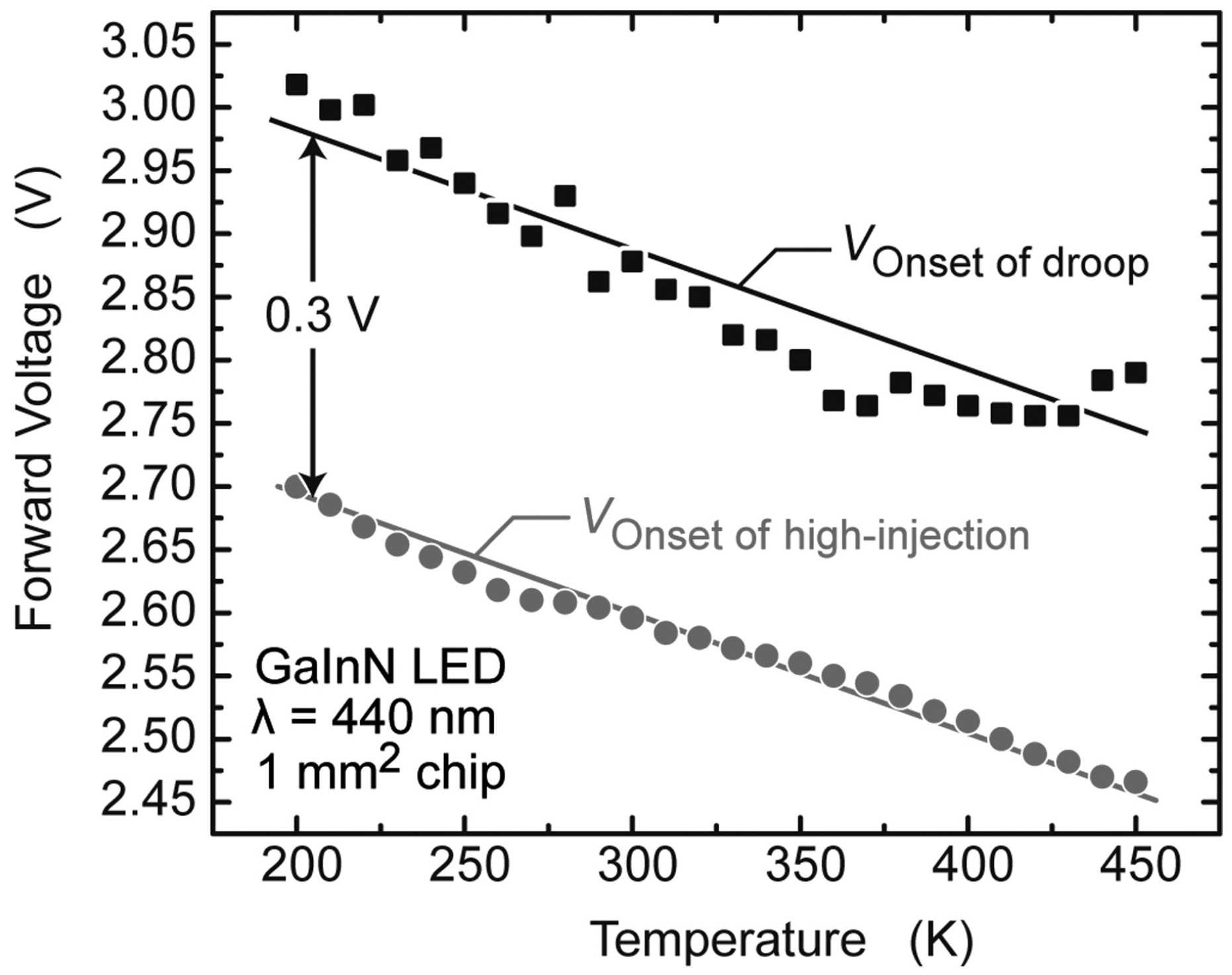
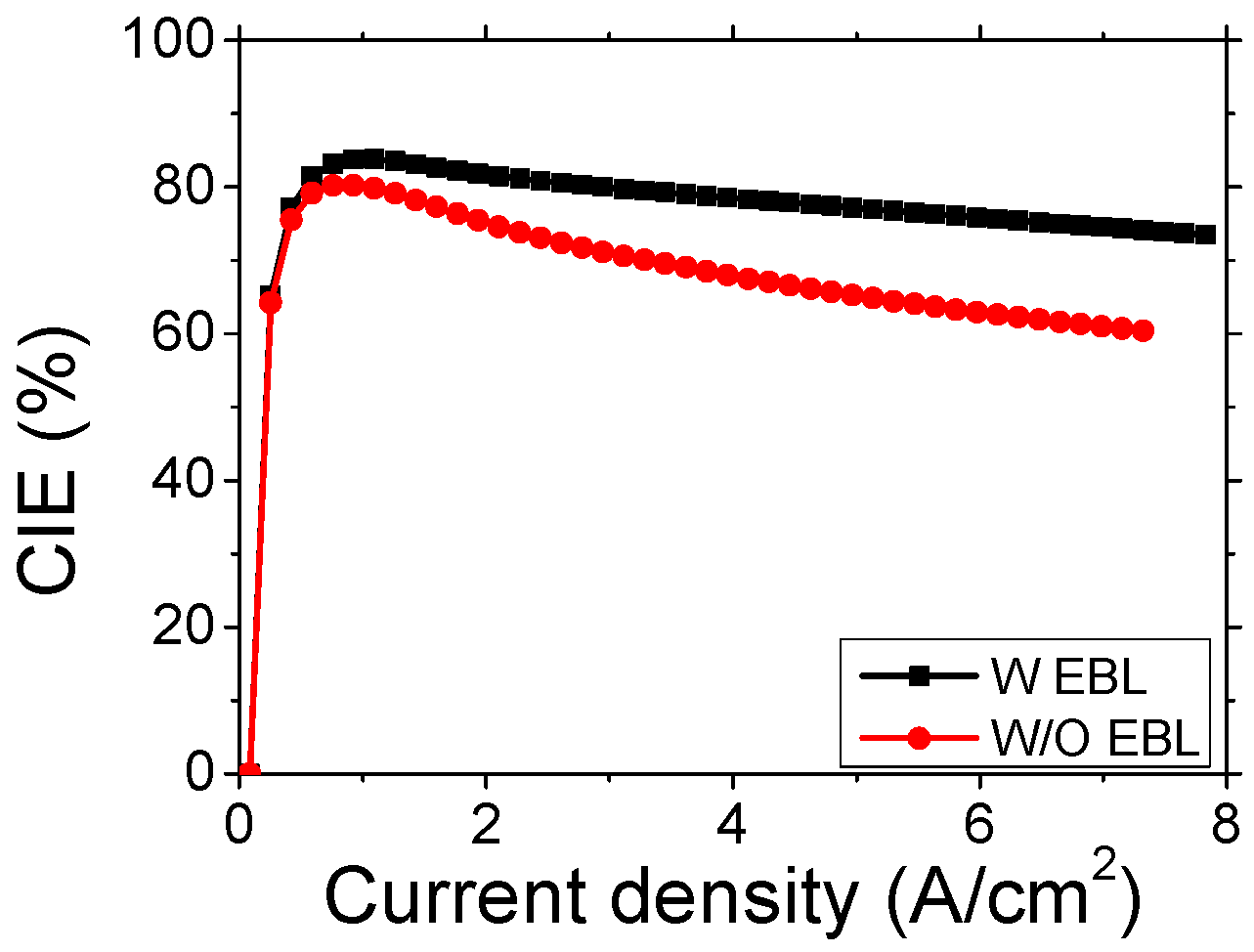
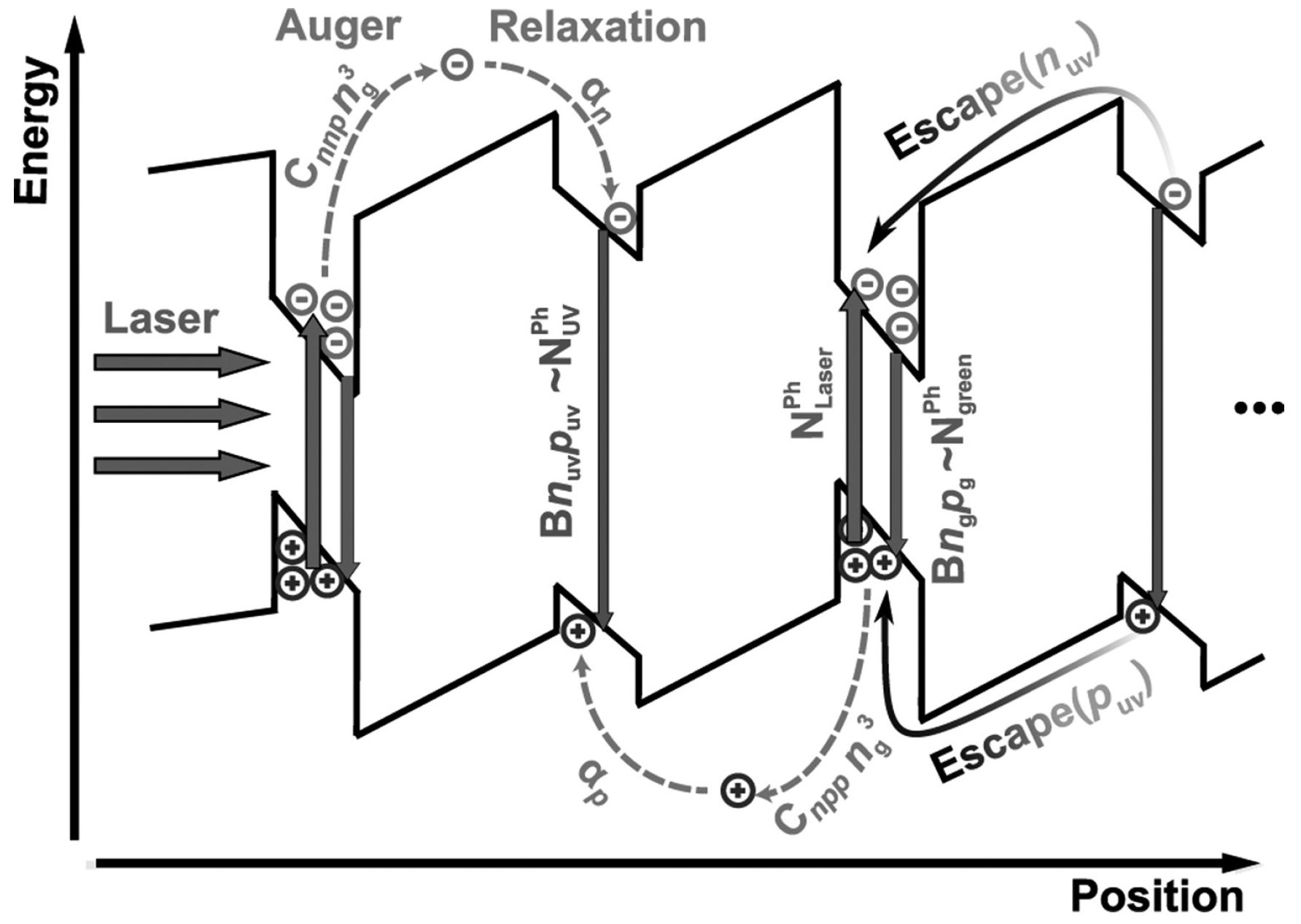
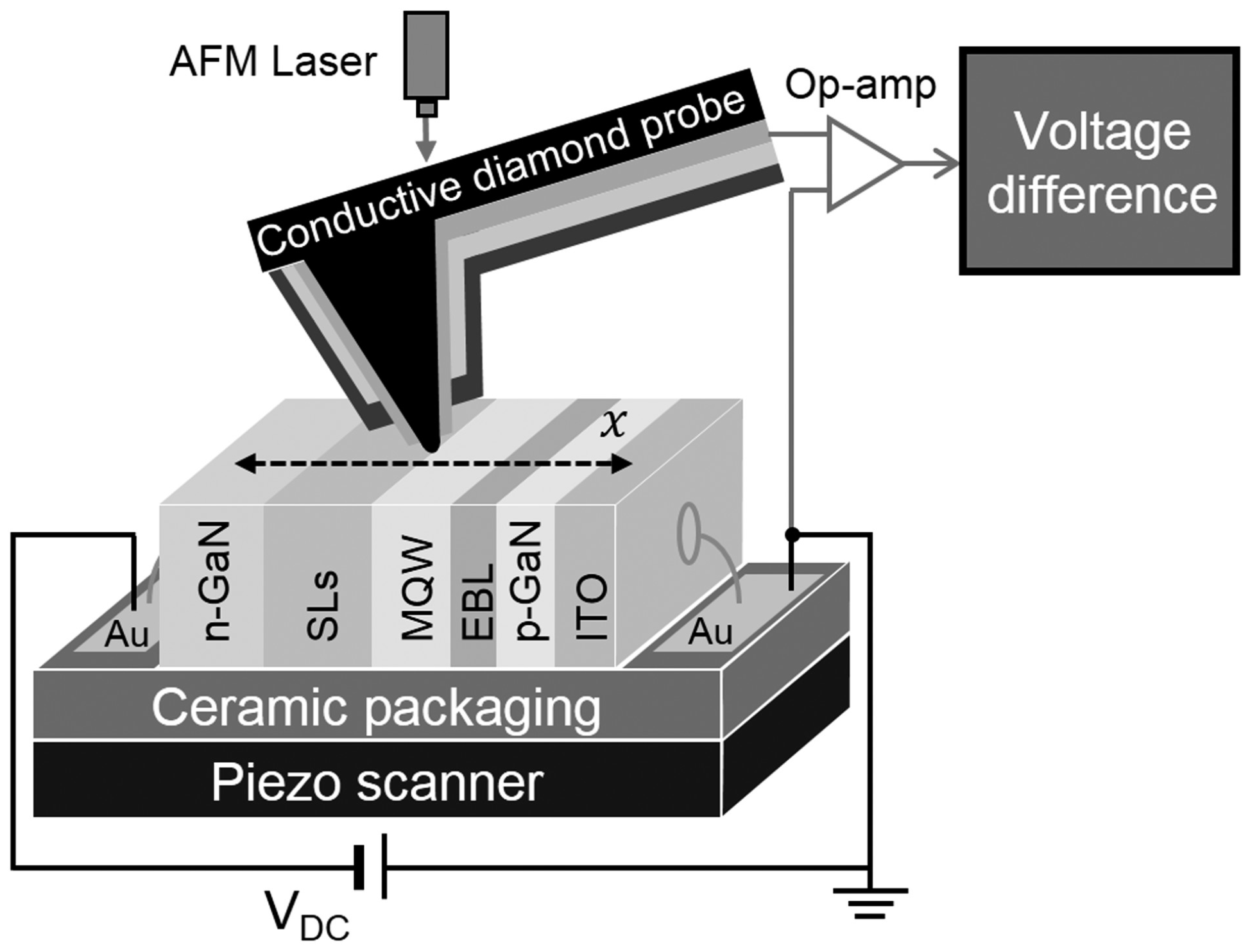
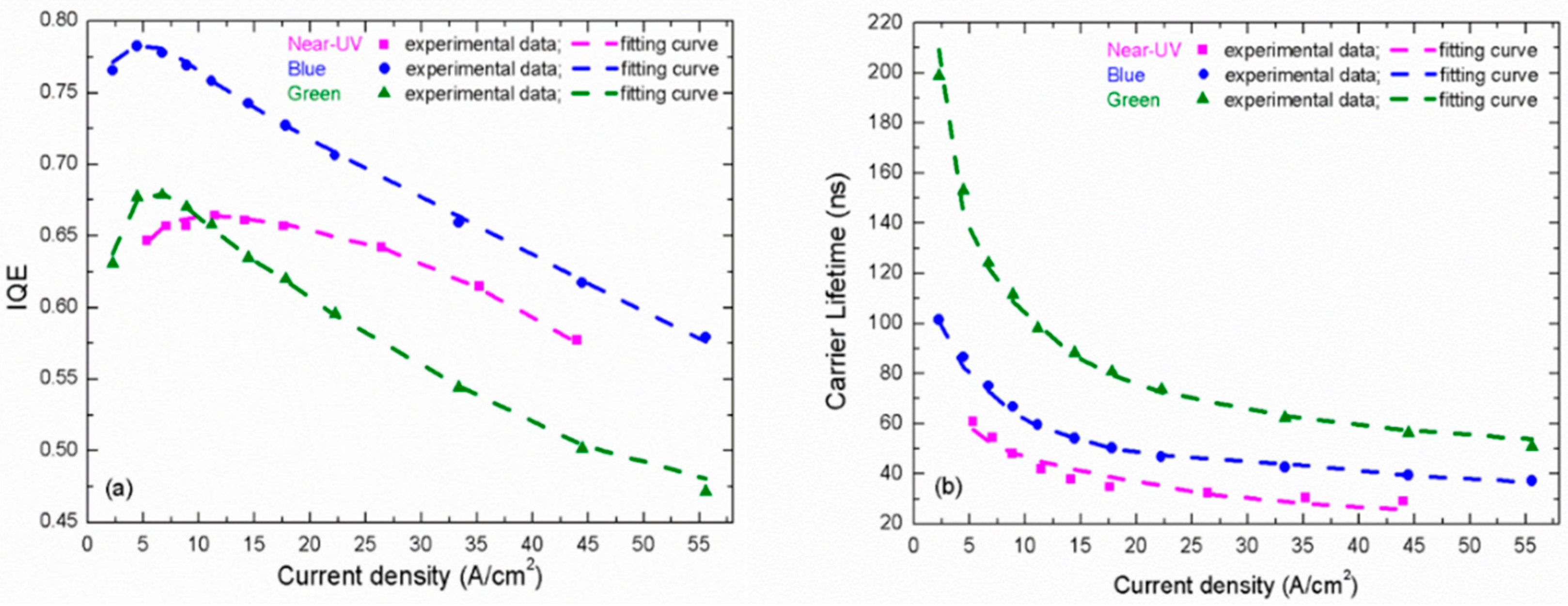
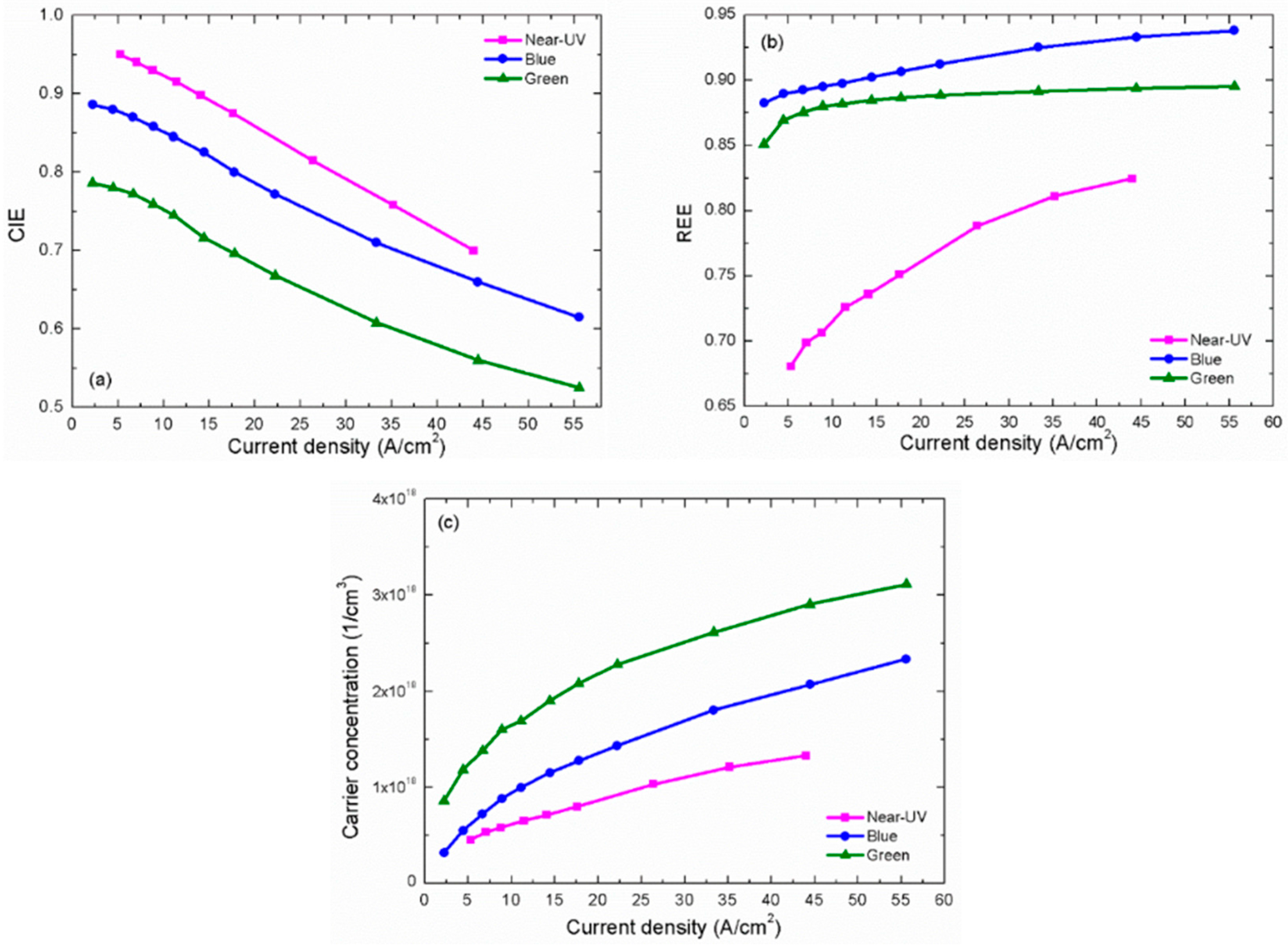
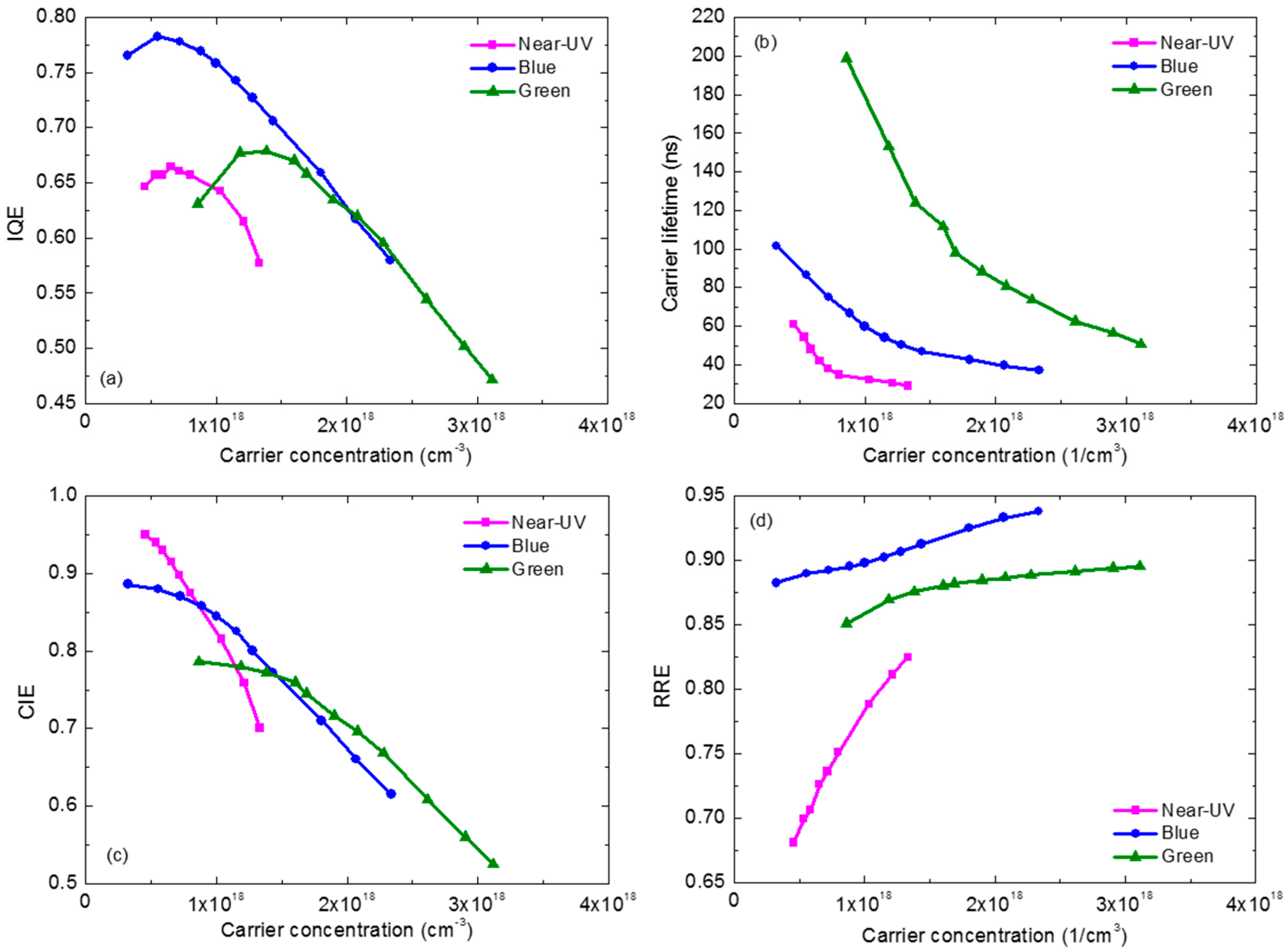
| LEDs | nC (cm−3) | k | AL (s−1) | ANL (s−1) | BL (cm3 s−1) | BNL (cm3 s−1) |
|---|---|---|---|---|---|---|
| Near-UV | 1.35 × 1017 | 2 | 1.25 × 106 | 1.9 × 106 | 18.5 × 10−12 | 13 × 10−12 |
| Blue 1 | 1.5 × 1017 | 2.8 | 0.25 × 106 | 1 × 106 | 14.8 × 10−12 | 6.4 × 10−12 |
| Green 2 | 4.8 × 1017 | 4.4 | 0.17 × 106 | 1.5 × 106 | 3 × 10−12 | 2.6 × 10−12 |
© 2017 by the authors. Licensee MDPI, Basel, Switzerland. This article is an open access article distributed under the terms and conditions of the Creative Commons Attribution (CC BY) license (http://creativecommons.org/licenses/by/4.0/).
Share and Cite
Wang, L.; Jin, J.; Mi, C.; Hao, Z.; Luo, Y.; Sun, C.; Han, Y.; Xiong, B.; Wang, J.; Li, H. A Review on Experimental Measurements for Understanding Efficiency Droop in InGaN-Based Light-Emitting Diodes. Materials 2017, 10, 1233. https://doi.org/10.3390/ma10111233
Wang L, Jin J, Mi C, Hao Z, Luo Y, Sun C, Han Y, Xiong B, Wang J, Li H. A Review on Experimental Measurements for Understanding Efficiency Droop in InGaN-Based Light-Emitting Diodes. Materials. 2017; 10(11):1233. https://doi.org/10.3390/ma10111233
Chicago/Turabian StyleWang, Lai, Jie Jin, Chenziyi Mi, Zhibiao Hao, Yi Luo, Changzheng Sun, Yanjun Han, Bing Xiong, Jian Wang, and Hongtao Li. 2017. "A Review on Experimental Measurements for Understanding Efficiency Droop in InGaN-Based Light-Emitting Diodes" Materials 10, no. 11: 1233. https://doi.org/10.3390/ma10111233
APA StyleWang, L., Jin, J., Mi, C., Hao, Z., Luo, Y., Sun, C., Han, Y., Xiong, B., Wang, J., & Li, H. (2017). A Review on Experimental Measurements for Understanding Efficiency Droop in InGaN-Based Light-Emitting Diodes. Materials, 10(11), 1233. https://doi.org/10.3390/ma10111233






